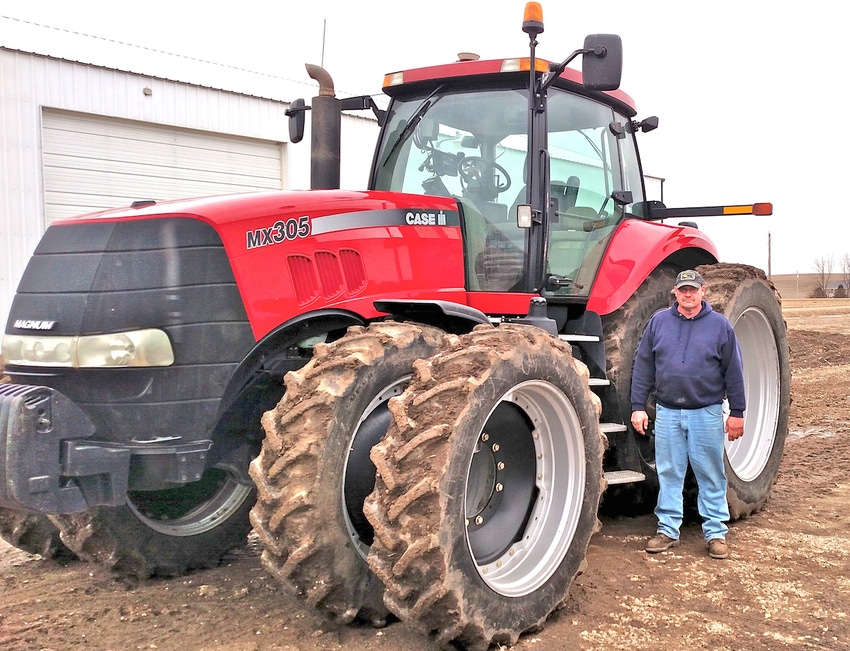March 10, 2015

Myron Klarenbeek got about one-third of his anticipated 2015 corn contracted early at $4 per bushel. But like many, he wishes he had pulled the trigger on more.
That price may look overly attractive come harvest time for the Rock Valley, Iowa, farmer-feeder, who markets much of his corn through his hogs. But getting a good price for the remaining bushels can be a bigger chore than keeping his finishing hogs happy.
In early February, cash-corn prices in the heart of the Midwest were at about $3.60 to $3.70. That was based on a typical negative basis off December 2015 corn trading at near $4. Early USDA crop reports still forecast more U.S. soybean acres and fewer corn acres for the year. But university grain marketing economists still see pressure on corn prices.
Klarenbeek farms with his son-in-law, Madison Dykstra, in far northwestern Iowa. He grows mainly corn, with some soybeans also planted most years, along with some alfalfa. “We also have facilities for about 2,400 finishing hogs and nursery space for about 3,500 head,” he says.
His hogs are marketed through a local grain and pork company. He is among several growers in a feeding group that supplies finished pigs to the operation. He rarely, if ever, has to buy outside corn for his pork program. “We feed only from our corn production,” he says. “I try to make about 75¢ to $1 per bushel in profit from that corn through hog sales. I have to market the remainder of it myself.”
Klarenbeek says that’s nearly always a challenge. He picks his price, sometimes based on recommendations he receives from his market advisor, Jon Scheve, of Superior Feed Ingredients, Waconia, Minn. “I’m not a fan of using the futures market,” he says. “I forward sell to a local elevator. When December ’15 futures increased to about $4.40, the local bid was about $4 cash.
“I contracted about a third of it. I should have contracted more. Now, with cash prices much lower, I need a little bit of a bump to get some more sales made.”
Klarenbeek also contracted some of his soybeans at about $9.65 cash last December, when November 2015 soybean futures were near $10.40. “I only try to market the amount of corn and bean production that is near my percentage of revenue crop insurance,” he says. “That’s usually at the 80% level. I’m more comfortable making forward sales when I already have some protection on my projected yields.”
A waiting game
Ed Usset, University of Minnesota grain marketing economist, sees little incentive for making corn and soybean sales at price levels seen early this year. “I’m not recommending getting aggressive at these levels,” he says. “I’m going to be patient and hope something better shows up this spring. Give me a spring rally and I’ll perk my ears up.”
Usset says he normally recommends that farmers begin marketing at their breakeven for cost of production. “Unfortunately, for Upper Midwest Corn Belt farmers, we’re 80-90¢ away on corn (with $3.80 to $4 futures prices),” he says. “Now, I’d say give me something half of that. Give me a $4.50 price and I’ll think about making some sales.”
His attitude is similar for beans. “At about $10 futures, we’re about $1.80 below breakeven,” he says. “Give me $10.50 to $11 this spring and I may pay attention. Otherwise, I’m willing to wait it out until harvest and see what I can do.”
USDA’s January crop report projected season-average corn farm prices at $3.35 to $3.95, up about 15¢ on both ends from late 2014, but nothing that will generate a big profit, says Chad Hart, Iowa State University (ISU) Extension grain marketing specialist, in a recent Iowa Farm Outlook.
USDA says season-average farm prices for soybeans are projected at $9.45 to $10.95, up some 20 cents from previous projections. Based on ISU’s estimated production costs, both corn and beans have roughly a minus-$60-per-acre margin, Hart says.
“Since last May, soybeans had led the margin race. But with the crop margins being similar now, the competition for acreage in 2015 should be interesting,” Hart says. “Neither crop is offering a strong incentive to grow it, but other crops aren’t offering much either.”
March madness
Hart says corn and bean markets will be dictated heavily by USDA’s March prospective plantings report. “The United States still represents roughly one-third of the world’s corn and soybean production,” he says. “And the acreage decisions outlined in the March report will set the stage for prices for the 2015 crops.
“With the per-acre margins equalizing and more pressure appearing in the soybean market from South America, I wonder if corn might not be able to retain more acres.”
Usset says with weak markets for corn and soybeans, finding a marketing strategy that generates a profit for either crop will be difficult. “I’m not about talking about locking in profits at the levels we discussed, I’m talking about minimizing losses,” he says.
Klarenbeek knows the days of strong corn and bean prices may be gone for a while, because of large domestic and world supplies. “We’ll just try to find a rally that offers a little more marketing incentive,” he says, “whether it’s with corn or beans.”
About the Author(s)
You May Also Like




